Urban Overheating Mitigation Strategies Opportunities: A Case Study of a Square in Rome (Italy)
Abstract
1. Introduction
1.1. Urban Heat Island Effects
1.2. Urban Heat Island and Landscape Relationship
1.3. Urban Heat Island Mitigation Strategies
1.4. Urban Heat Island Studies in the City of Rome
1.5. Aim of this Study
2. Materials and Methods
2.1. Methodology
- Selection of a densely populated urban area characterized by few green areas;
- Assessment of the Urban Heat Island Intensity (UHII) able to justify the choice of the urban area chosen in the point 1. The UHII is calculated as the maximum daily difference of the outdoor air temperature of the examined area and a reference one that must be a rural area near the city. The values are calculated as the following:
- Identification of the more effective strategies, starting from the best practices applied in other case studies;
- Experimental monitoring, taking into account the geometry, the albedo of the buildings and environmental conditions in terms of temperature, rainfalls, relative humidity, solar radiation and wind speed;
- Numerical modelling generation and calibration using ENVI_met;
- Mitigation techniques analysis through the use of numerical simulation. The data related to the improved scenarios will be compared to the ones of the initial configuration.
- Implementation on the geometrical characteristics of buildings, trees, vegetation, roads and soils throughout the use of Google Earth aerial view of the zone;
- Setup the material characteristics of the building envelope, road, soils, trees and vegetation, with also the implementation of the on-site albedo measurement;
- Setup the initial conditions of data used for the numerical simulations, and setup the forced input of air temperature and relative humidity conditions of the boundary with data acquired by a weather monitoring station placed near the simulation domain;
- Numerical model calibration step that consists of checking, simulation after simulation, the relative error of simulated and measured data where the weather station was installed. In each simulation, to minimize this error, it is possible to correct point by point the forced input data of the numerical model related to the air temperature and relative humidity.The difference between the experimental data and the simulated ones were assessed using two statistical indices. The quantitative indicators [61] used in this work are, taking into account the model-predicted and observed variables at each instant , and the amount of examined data , respectively:
- Mean Bias Error (MBE): it shows if the model values exceed or undervalue the observed data. Because they set off against one another, this indicator does not function properly when anticipated values are alternately overestimated and underestimated.
- Mean Absolute Error (MAE): it is similar to the MBE indicator, but accounting for the absolute difference between expected and actual values. Therefore, this indication is helpful when the projected values alternate between being overestimated and underestimated.
- Implementation of the different mitigation strategies to be used and assessment simulation in order to evaluate the variation of the thermal conditions inside the objected area of the study.
2.2. The Case Study
2.3. Mitigation Strategies
- The use of cool pavements, with high values of albedo and permeability, with an albedo equal to 0.50;
- The use of grass pavers instead the traditional asphalt;
- Increase of vegetation, with species similar to those already present;
- Introduction of shading projecting roof in Mancini Square.
2.4. Experimental Campain
2.5. Numerical Model Setup
3. Results and Discussion
3.1. Assesment of the Urban Heat Island Intensity
3.2. Numerical Model Calibration
3.3. Numerical Models of Mitigation Strategies
3.4. Air Temperature Spatial Variation
3.5. Time Variation of Air Temperature
4. Conclusions
Author Contributions
Funding
Institutional Review Board Statement
Informed Consent Statement
Data Availability Statement
Acknowledgments
Conflicts of Interest
References
- Urbanization over the Past 500 Years, 1500 to 2016. Available online: https://ourworldindata.org/grapher/urbanization-last-500-years?country=IND~CHN~OWID_WRL~USA~JPN (accessed on 30 October 2022).
- Pesaresi, M.; Melchiorri, M.; Siragusa, A.; Kemper, T. Atlas of the Human Planet—Mapping Human Presence on Earth with the Global Human Settlement Layer; Publications Office of the European Union: Luxembourg, 2016. [Google Scholar] [CrossRef]
- Number of People Living in Urban and Rural Areas. Available online: https://ourworldindata.org/grapher/urban-and-rural-population (accessed on 30 October 2022).
- Mohammad Harmay, N.S.; Kim, D.; Choi, M. Urban Heat Island Associated with Land Use/Land Cover and Climate Variations in Melbourne, Australia. Sustain. Cities Soc. 2021, 69, 102861. [Google Scholar] [CrossRef]
- Vallati, A.; Mauri, L.; Colucci, C. Impact of Shortwave Multiple Reflections in an Urban Street Canyon on Building Thermal Energy Demands. Energy Build. 2018, 174, 77–84. [Google Scholar] [CrossRef]
- Memon, R.A.; Leung, D.Y.C.; Liu, C.H. An Investigation of Urban Heat Island Intensity (UHII) as an Indicator of Urban Heating. Atmos. Res. 2009, 94, 491–500. [Google Scholar] [CrossRef]
- Howard, L. The Climate of London; Cambridge University Press: Cambridge, UK, 2012; p. 384. ISBN 9781108049528. [Google Scholar]
- Yuan, J.; Farnham, C.; Emura, K. Performance of Retro-Reflective Building Envelope Materials with Fixed Glass Beads. Appl. Sci. 2019, 9, 1714. [Google Scholar] [CrossRef]
- Gabriel, K.M.A.; Endlicher, W.R. Urban and Rural Mortality Rates during Heat Waves in Berlin and Brandenburg, Germany. Environ. Pollut. 2011, 159, 2044–2050. [Google Scholar] [CrossRef]
- Battista, G.; Evangelisti, L.; Guattari, C.; de Lieto Vollaro, E.; de Lieto Vollaro, R.; Asdrubali, F. Urban Heat Island Mitigation Strategies: Experimental and Numerical Analysis of a University Campus in Rome (Italy). Sustainability 2020, 12, 7971. [Google Scholar] [CrossRef]
- Li, X.; Zhou, Y.; Yu, S.; Jia, G.; Li, H.; Li, W. Urban Heat Island Impacts on Building Energy Consumption: A Review of Approaches and Findings. Energy 2019, 174, 407–419. [Google Scholar] [CrossRef]
- Yang, X.; Peng, L.L.H.; Jiang, Z.; Chen, Y.; Yao, L.; He, Y.; Xu, T. Impact of Urban Heat Island on Energy Demand in Buildings: Local Climate Zones in Nanjing. Appl. Energy 2020, 260, 114279. [Google Scholar] [CrossRef]
- Kaloustian, N.; Aouad, D.; Battista, G.; Zinzi, M. Leftover Spaces for the Mitigation of Urban Overheating in Municipal Beirut. Climate 2018, 6, 68. [Google Scholar] [CrossRef]
- Larsen, M.A.D.; Petrović, S.; Radoszynski, A.M.; McKenna, R.; Balyk, O. Climate Change Impacts on Trends and Extremes in Future Heating and Cooling Demands over Europe. Energy Build. 2020, 226, 110397. [Google Scholar] [CrossRef]
- Abbassi, Y.; Ahmadikia, H.; Baniasadi, E. Prediction of Pollution Dispersion under Urban Heat Island Circulation for Different Atmospheric Stratification. Build. Environ. 2020, 168, 106374. [Google Scholar] [CrossRef]
- Battista, G. Analysis of the Air Pollution Sources in the City of Rome (Italy). Energy Procedia 2017, 126, 392–397. [Google Scholar] [CrossRef]
- Du, Y.; Mak, C.M.; Li, Y. A Multi-Stage Optimization of Pedestrian Level Wind Environment and Thermal Comfort with Lift-up Design in Ideal Urban Canyons. Sustain. Cities Soc. 2019, 46, 101424. [Google Scholar] [CrossRef]
- Falasca, S.; Ciancio, V.; Salata, F.; Golasi, I.; Rosso, F.; Curci, G. High Albedo Materials to Counteract Heat Waves in Cities: An Assessment of Meteorology, Buildings Energy Needs and Pedestrian Thermal Comfort. Build. Environ. 2019, 163, 106242. [Google Scholar] [CrossRef]
- Yang, J.; Jin, S.; Xiao, X.; Jin, C.; Xia, J.; Li, X.; Wang, S. Local Climate Zone Ventilation and Urban Land Surface Temperatures: Towards a Performance-Based and Wind-Sensitive Planning Proposal in Megacities. Sustain. Cities Soc. 2019, 47, 101487. [Google Scholar] [CrossRef]
- Morabito, M.; Crisci, A.; Messeri, A.; Orlandini, S.; Raschi, A.; Maracchi, G.; Munafò, M. The Impact of Built-up Surfaces on Land Surface Temperatures in Italian Urban Areas. Sci. Total Environ. 2016, 551–552, 317–326. [Google Scholar] [CrossRef]
- Ma, Q.; Wu, J.; He, C. A Hierarchical Analysis of the Relationship between Urban Impervious Surfaces and Land Surface Temperatures: Spatial Scale Dependence, Temporal Variations, and Bioclimatic Modulation. Landsc. Ecol. 2016, 31, 1139–1153. [Google Scholar] [CrossRef]
- Zhang, H.; Qi, Z.f.; Ye, X.y.; Cai, Y.b.; Ma, W.c.; Chen, M. nan Analysis of Land Use/Land Cover Change, Population Shift, and Their Effects on Spatiotemporal Patterns of Urban Heat Islands in Metropolitan Shanghai, China. Appl. Geogr. 2013, 44, 121–133. [Google Scholar] [CrossRef]
- Mallick, J.; Rahman, A.; Singh, C.K. Modeling Urban Heat Islands in Heterogeneous Land Surface and Its Correlation with Impervious Surface Area by Using Night-Time ASTER Satellite Data in Highly Urbanizing City, Delhi-India. Adv. Space Res. 2013, 52, 639–655. [Google Scholar] [CrossRef]
- Chapman, S.; Watson, J.E.M.; Salazar, A.; Thatcher, M.; McAlpine, C.A. The Impact of Urbanization and Climate Change on Urban Temperatures: A Systematic Review. Landsc. Ecol. 2017, 32, 1921–1935. [Google Scholar] [CrossRef]
- Sun, F.; Liu, M.; Wang, Y.; Wang, H.; Che, Y. The Effects of 3D Architectural Patterns on the Urban Surface Temperature at a Neighborhood Scale: Relative Contributions and Marginal Effects. J. Clean. Prod. 2020, 258, 120706. [Google Scholar] [CrossRef]
- Hu, Y.; Dai, Z.; Guldmann, J.M. Modeling the Impact of 2D/3D Urban Indicators on the Urban Heat Island over Different Seasons: A Boosted Regression Tree Approach. J. Environ. Manag. 2020, 266, 110424. [Google Scholar] [CrossRef] [PubMed]
- Parizotto, S.; Lamberts, R. Investigation of Green Roof Thermal Performance in Temperate Climate: A Case Study of an Experimental Building in Florianópolis City, Southern Brazil. Energy Build. 2011, 43, 1712–1722. [Google Scholar] [CrossRef]
- Bollman, M.A.; DeSantis, G.E.; Waschmann, R.S.; Mayer, P.M. Effects of Shading and Composition on Green Roof Media Temperature and Moisture. J. Environ. Manag. 2021, 281, 111882. [Google Scholar] [CrossRef]
- Roman, K.K.; O’Brien, T.; Alvey, J.B.; Woo, O.J. Simulating the Effects of Cool Roof and PCM (Phase Change Materials) Based Roof to Mitigate UHI (Urban Heat Island) in Prominent US Cities. Energy 2016, 96, 103–117. [Google Scholar] [CrossRef]
- Diz-Mellado, E.; López-Cabeza, V.P.; Rivera-Gómez, C.; Roa-Fernández, J.; Galán-Marín, C. Improving School Transition Spaces Microclimate to Make Them Liveable in Warm Climates. Appl. Sci. 2020, 10, 7648. [Google Scholar] [CrossRef]
- Aboelata, A. Vegetation in Different Street Orientations of Aspect Ratio (H/W 1:1) to Mitigate UHI and Reduce Buildings’ Energy in Arid Climate. Build. Environ. 2020, 172, 106712. [Google Scholar] [CrossRef]
- Theeuwes, N.E.; Solcerová, A.; Steeneveld, G.J. Modeling the Influence of Open Water Surfaces on the Summertime Temperature and Thermal Comfort in the City. J. Geophys. Res. Atmos. 2013, 118, 8881–8896. [Google Scholar] [CrossRef]
- Fahed, J.; Kinab, E.; Ginestet, S.; Adolphe, L. Impact of Urban Heat Island Mitigation Measures on Microclimate and Pedestrian Comfort in a Dense Urban District of Lebanon. Sustain. Cities Soc. 2020, 61, 102375. [Google Scholar] [CrossRef]
- Battista, G.; de Lieto Vollaro, E.; Grignaffini, S.; Ocłoń, P.; Vallati, A. Experimental Investigation about the Adoption of High Reflectance Materials on the Envelope Cladding on a Scaled Street Canyon. Energy 2021, 230, 120801. [Google Scholar] [CrossRef]
- Vollaro, A.D.L.; Galli, G.; Vallati, A.; Romagnoli, R. Analysis of Thermal Field within an Urban Canyon with Variable Thermophysical Characteristics of the Building’s Walls. J. Phys. Conf. Ser. 2015, 655, 012056. [Google Scholar] [CrossRef]
- Synnefa, A.; Karlessi, T.; Gaitani, N.; Santamouris, M.; Assimakopoulos, D.N.; Papakatsikas, C. Experimental Testing of Cool Colored Thin Layer Asphalt and Estimation of Its Potential to Improve the Urban Microclimate. Build. Environ. 2011, 46, 38–44. [Google Scholar] [CrossRef]
- Rossi, F.; Pisello, A.L.; Nicolini, A.; Filipponi, M.; Palombo, M. Analysis of Retro-Reflective Surfaces for Urban Heat Island Mitigation: A New Analytical Model. Appl. Energy 2014, 114, 621–631. [Google Scholar] [CrossRef]
- Santamouris, M. Using Cool Pavements as a Mitigation Strategy to Fight Urban Heat Island—A Review of the Actual Developments. Renew. Sustain. Energy Rev. 2013, 26, 224–240. [Google Scholar] [CrossRef]
- Battista, G.; de Lieto Vollaro, E.; de Lieto Vollaro, R. How Cool Pavements and Green Roof Affect Building Energy Performances. Heat Transfer Eng. 2021, 43, 326–336. [Google Scholar] [CrossRef]
- Georgakis, C.; Zoras, S.; Santamouris, M. Studying the Effect of “Cool” Coatings in Street Urban Canyons and Its Potential as a Heat Island Mitigation Technique. Sustain. Cities Soc. 2014, 13, 20–31. [Google Scholar] [CrossRef]
- Peron, F.; de Maria, M.M.; Spinazzè, F.; Mazzali, U. An Analysis of the Urban Heat Island of Venice Mainland. Sustain. Cities Soc. 2015, 19, 300–309. [Google Scholar] [CrossRef]
- Wang, J.; Meng, Q.; Tan, K.; Zhang, L.; Zhang, Y. Experimental Investigation on the Influence of Evaporative Cooling of Permeable Pavements on Outdoor Thermal Environment. Build. Environ. 2018, 140, 184–193. [Google Scholar] [CrossRef]
- Xiao, X.D.; Dong, L.; Yan, H.; Yang, N.; Xiong, Y. The Influence of the Spatial Characteristics of Urban Green Space on the Urban Heat Island Effect in Suzhou Industrial Park. Sustain. Cities Soc. 2018, 40, 428–439. [Google Scholar] [CrossRef]
- Qin, Y. A Review on the Development of Cool Pavements to Mitigate Urban Heat Island Effect. Renew. Sustain. Energy Rev. 2015, 52, 445–459. [Google Scholar] [CrossRef]
- Li, H. A Comparison of Thermal Performance of Different Pavement Materials. In Eco-efficient Materials for Mitigating Building Cooling Needs: Design, Properties and Applications; Woodhead Publishing: Sawston, UK, 2015; pp. 63–124. [Google Scholar] [CrossRef]
- Li, H.; Harvey, J.; Ge, Z. Experimental Investigation on Evaporation Rate for Enhancing Evaporative Cooling Effect of Permeable Pavement Materials. Constr. Build. Mater. 2014, 65, 367–375. [Google Scholar] [CrossRef]
- Oke, T.R. The Energetic Basis of the Urban Heat Island. Quart. J. R. Met. Soc. 1982, 108, 551. [Google Scholar] [CrossRef]
- Akbari, H.; Pomerantz, M.; Taha, H. Cool Surfaces and Shade Trees to Reduce Energy Use and Improve Air Quality in Urban Areas. Sol. Energy 2001, 70, 295–310. [Google Scholar] [CrossRef]
- Stone, B.; Norman, J.M. Land Use Planning and Surface Heat Island Formation: A Parcel-Based Radiation Flux Approach. Atmos. Environ. 2006, 40, 3561–3573. [Google Scholar] [CrossRef]
- Stone, B.; Hess, J.J.; Frumkin, H. Urban Form and Extreme Heat Events: Are Sprawling Cities More Vulnerable to Climate Change than Compact Cities? Environ. Health Perspect. 2010, 118, 1425–1428. [Google Scholar] [CrossRef]
- Santamouris, M. Regulating the Damaged Thermostat of the Cities—Status, Impacts and Mitigation Challenges. Energy Build. 2015, 91, 43–56. [Google Scholar] [CrossRef]
- Doick, K.J.; Peace, A.; Hutchings, T.R. The Role of One Large Greenspace in Mitigating London’s Nocturnal Urban Heat Island. Sci. Total Environ. 2014, 493, 662–671. [Google Scholar] [CrossRef]
- Tan, C.L.; Wong, N.H.; Jusuf, S.K.; Chiam, Z.Q. Impact of Plant Evapotranspiration Rate and Shrub Albedo on Temperature Reduction in the Tropical Outdoor Environment. Build. Environ. 2015, 94, 206–217. [Google Scholar] [CrossRef]
- Battista, G.; Pastore, E.M.; Mauri, L.; Basilicata, C. Green Roof Effects in a Case Study of Rome (Italy). Energy Procedia 2016, 101, 1058–1063. [Google Scholar] [CrossRef]
- Zinzi, M.; Agnoli, S.; Burattini, C.; Mattoni, B. On the Thermal Response of Buildings under the Synergic Effect of Heat Waves and Urban Heat Island. Solar Energy 2020, 211, 1270–1282. [Google Scholar] [CrossRef]
- Zinzi, M.; Carnielo, E.; Mattoni, B. On the Relation between Urban Climate and Energy Performance of Buildings. A Three-Years Experience in Rome, Italy. Appl. Energy 2018, 221, 148–160. [Google Scholar] [CrossRef]
- Cecilia, A.; Casasanta, G.; Petenko, I.; Conidi, A.; Argentini, S. Measuring the Urban Heat Island of Rome through a Dense Weather Station Network and Remote Sensing Imperviousness Data. Urban Clim. 2023, 47, 101355. [Google Scholar] [CrossRef]
- Battista, G.; Evangelisti, L.; Guattari, C.; Roncone, M.; Balaras, C.A. Space-Time Estimation of the Urban Heat Island in Rome (Italy): Overall Assessment and Effects on the Energy Performance of Buildings. Build. Environ. 2023, 228, 109878. [Google Scholar] [CrossRef]
- Battista, G.; de Lieto Vollaro, R.; Zinzi, M. Assessment of Urban Overheating Mitigation Strategies in a Square in Rome, Italy. Sol. Energy 2019, 180, 608–621. [Google Scholar] [CrossRef]
- Salata, F.; Golasi, I.; de Lieto Vollaro, R.; de Lieto Vollaro, A. Outdoor Thermal Comfort in the Mediterranean Area. A Transversal Study in Rome, Italy. Build. Environ. 2016, 96, 46–61. [Google Scholar] [CrossRef]
- Battista, G.; Carnielo, E.; de Lieto Vollaro, R. Thermal Impact of a Redeveloped Area on Localized Urban Microclimate: A Case Study in Rome. Energy Build. 2016, 133, 446–454. [Google Scholar] [CrossRef]
- Morini, E.; Touchaei, A.G.; Rossi, F.; Cotana, F.; Akbari, H. Evaluation of Albedo Enhancement to Mitigate Impacts of Urban Heat Island in Rome (Italy) Using WRF Meteorological Model. Urban Clim. 2018, 24, 551–566. [Google Scholar] [CrossRef]
- Salata, F.; Golasi, I.; Petitti, D.; de Lieto Vollaro, E.; Coppi, M.; de Lieto Vollaro, A. Relating Microclimate, Human Thermal Comfort and Health during Heat Waves: An Analysis of Heat Island Mitigation Strategies through a Case Study in an Urban Outdoor Environment. Sustain. Cities Soc. 2017, 30, 79–96. [Google Scholar] [CrossRef]
- Iaria, J.; Susca, T. Analytic Hierarchy Processes (AHP) Evaluation of Green Roof- and Green Wall- Based UHI Mitigation Strategies via ENVI-Met Simulations. Urban Clim. 2022, 46, 101293. [Google Scholar] [CrossRef]
- Battista, G.; Pastore, E.M. Using Cool Pavements to Mitigate Urban Temperatures in a Case Study of Rome (Italy). Energy Procedia 2017, 113, 98–103. [Google Scholar] [CrossRef]
- Costanzo, V.; Evola, G.; Marletta, L. Energy Savings in Buildings or UHI Mitigation? Comparison between Green Roofs and Cool Roofs. Energy Build. 2016, 114, 247–255. [Google Scholar] [CrossRef]
- Marando, F.; Salvatori, E.; Sebastiani, A.; Fusaro, L.; Manes, F. Regulating Ecosystem Services and Green Infrastructure: Assessment of Urban Heat Island Effect Mitigation in the Municipality of Rome, Italy. Ecol. Model. 2019, 392, 92–102. [Google Scholar] [CrossRef]
- Di Giuseppe, E.; Pergolini, M.; Stazi, F. Numerical Assessment of the Impact of Roof Reflectivity and Building Envelope Thermal Transmittance on the UHI Effect. Energy Procedia 2017, 134, 404–413. [Google Scholar] [CrossRef]
- Salvati, A.; Monti, P.; Coch Roura, H.; Cecere, C. Climatic Performance of Urban Textures: Analysis Tools for a Mediterranean Urban Context. Energy Build. 2019, 185, 162–179. [Google Scholar] [CrossRef]
- ENVI-Met—Decode Urban Nature with Microclimate Simulations. Available online: https://www.envi-met.com/it/ (accessed on 30 October 2022).

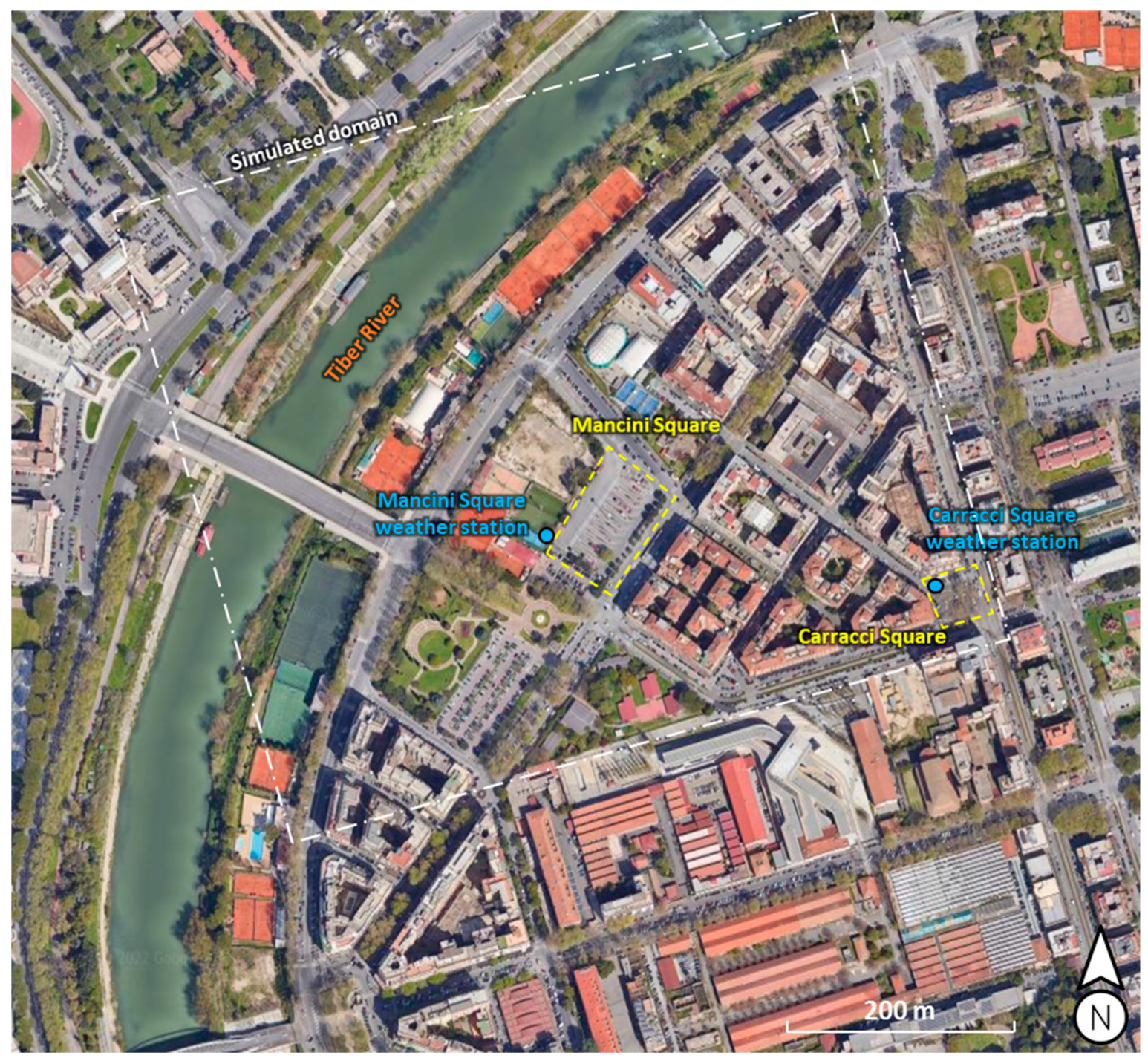
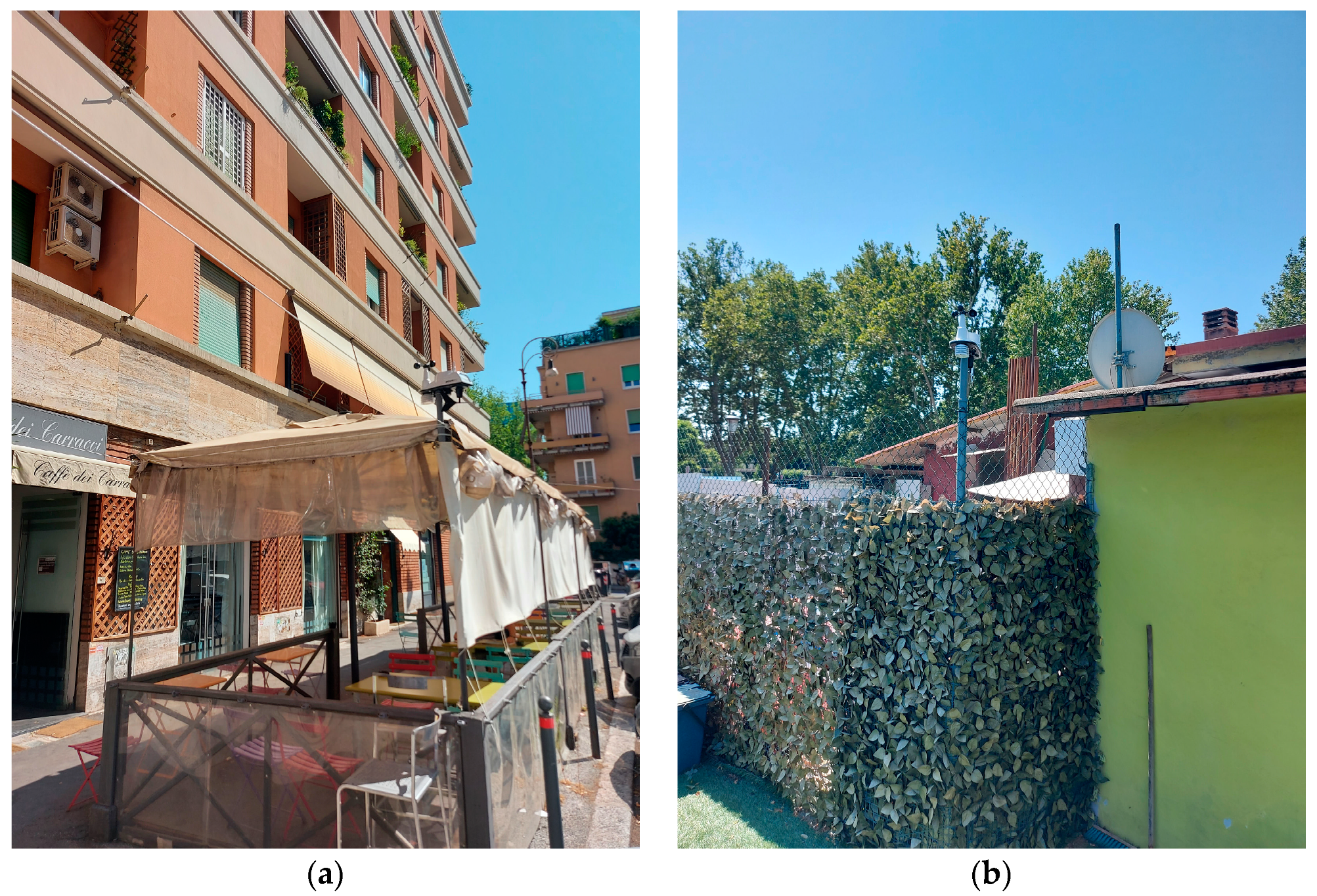
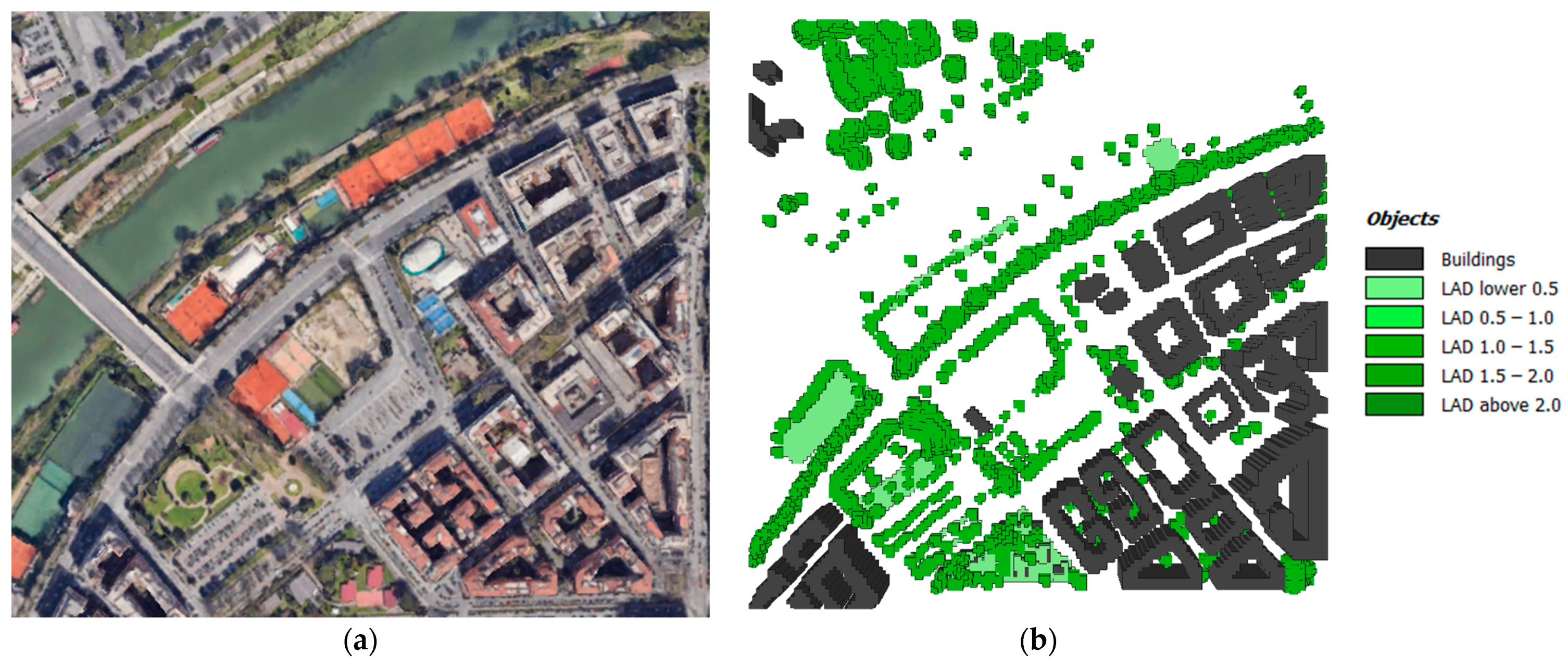
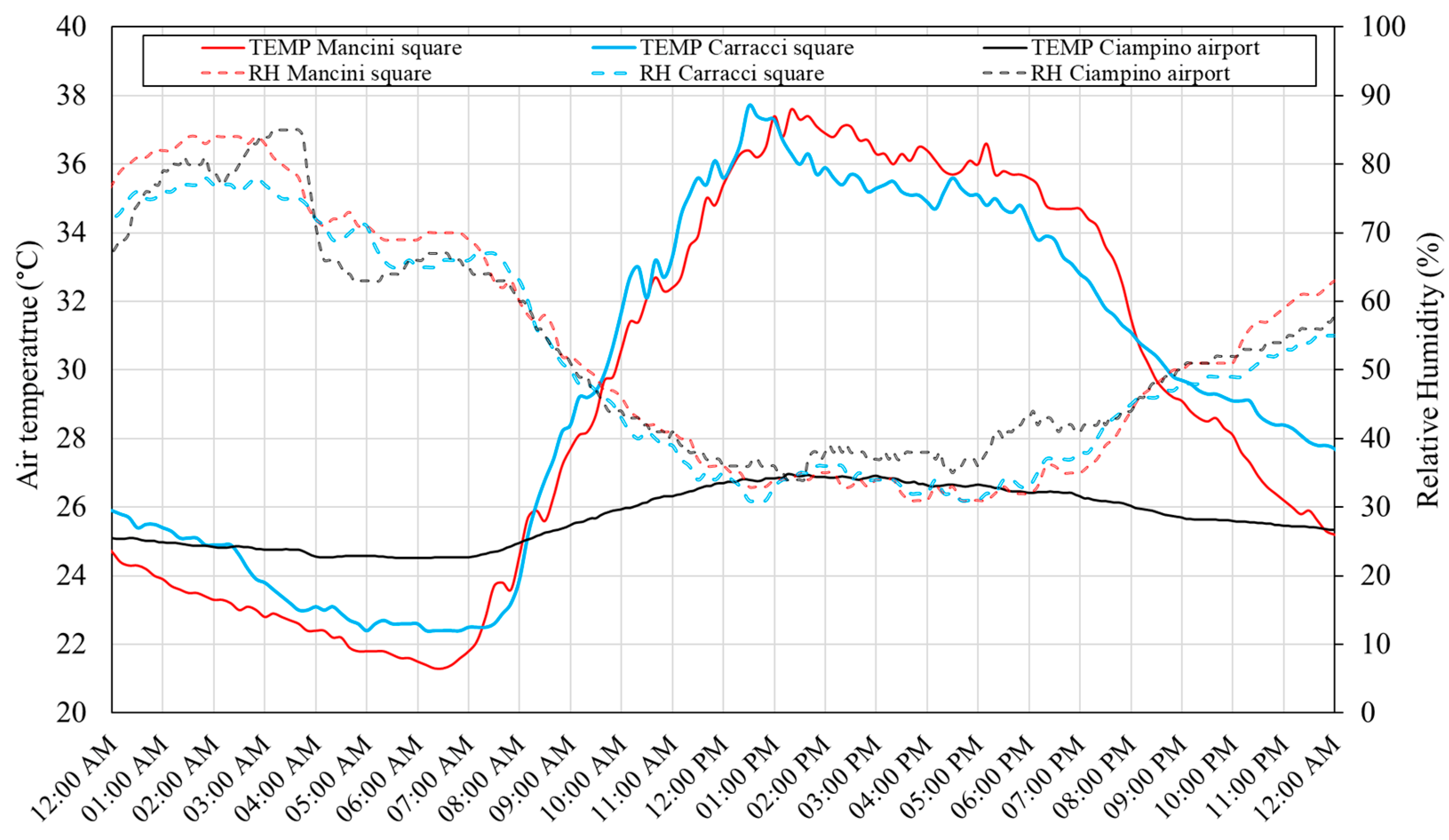
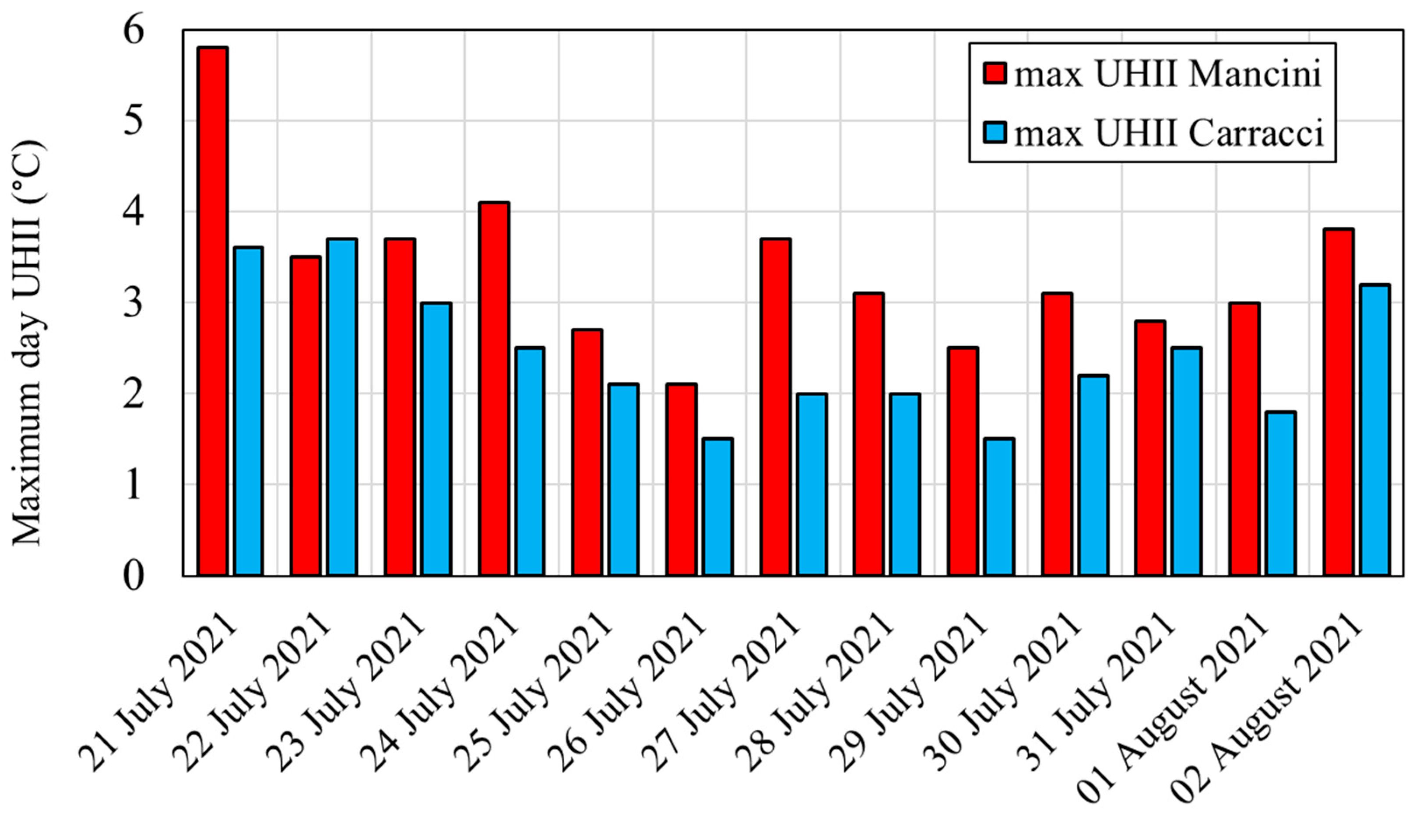

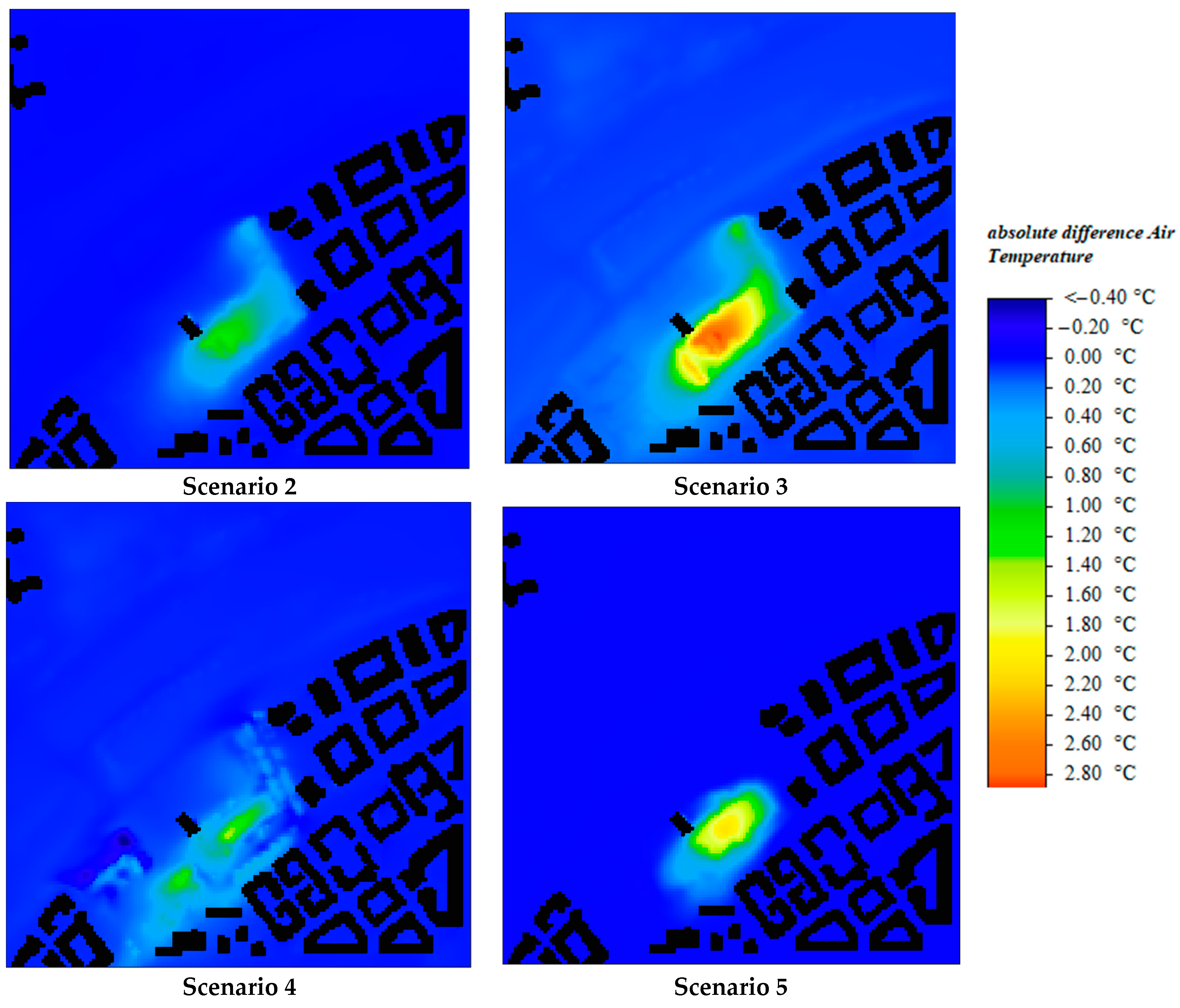

Publisher’s Note: MDPI stays neutral with regard to jurisdictional claims in published maps and institutional affiliations. |
© 2022 by the authors. Licensee MDPI, Basel, Switzerland. This article is an open access article distributed under the terms and conditions of the Creative Commons Attribution (CC BY) license (https://creativecommons.org/licenses/by/4.0/).
Share and Cite
Battista, G.; de Lieto Vollaro, E.; Evangelisti, L.; de Lieto Vollaro, R. Urban Overheating Mitigation Strategies Opportunities: A Case Study of a Square in Rome (Italy). Sustainability 2022, 14, 16939. https://doi.org/10.3390/su142416939
Battista G, de Lieto Vollaro E, Evangelisti L, de Lieto Vollaro R. Urban Overheating Mitigation Strategies Opportunities: A Case Study of a Square in Rome (Italy). Sustainability. 2022; 14(24):16939. https://doi.org/10.3390/su142416939
Chicago/Turabian StyleBattista, Gabriele, Emanuele de Lieto Vollaro, Luca Evangelisti, and Roberto de Lieto Vollaro. 2022. "Urban Overheating Mitigation Strategies Opportunities: A Case Study of a Square in Rome (Italy)" Sustainability 14, no. 24: 16939. https://doi.org/10.3390/su142416939
APA StyleBattista, G., de Lieto Vollaro, E., Evangelisti, L., & de Lieto Vollaro, R. (2022). Urban Overheating Mitigation Strategies Opportunities: A Case Study of a Square in Rome (Italy). Sustainability, 14(24), 16939. https://doi.org/10.3390/su142416939








